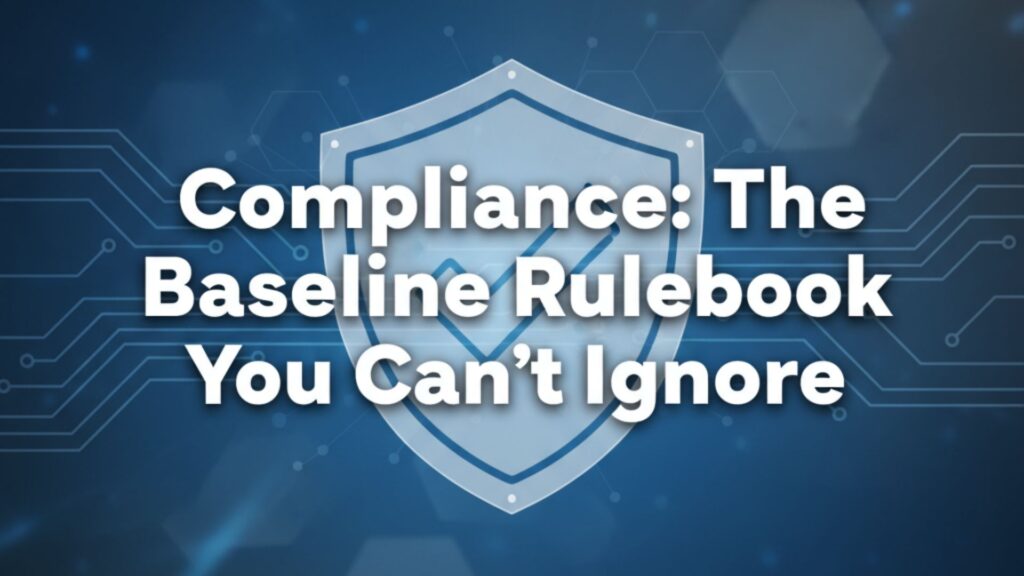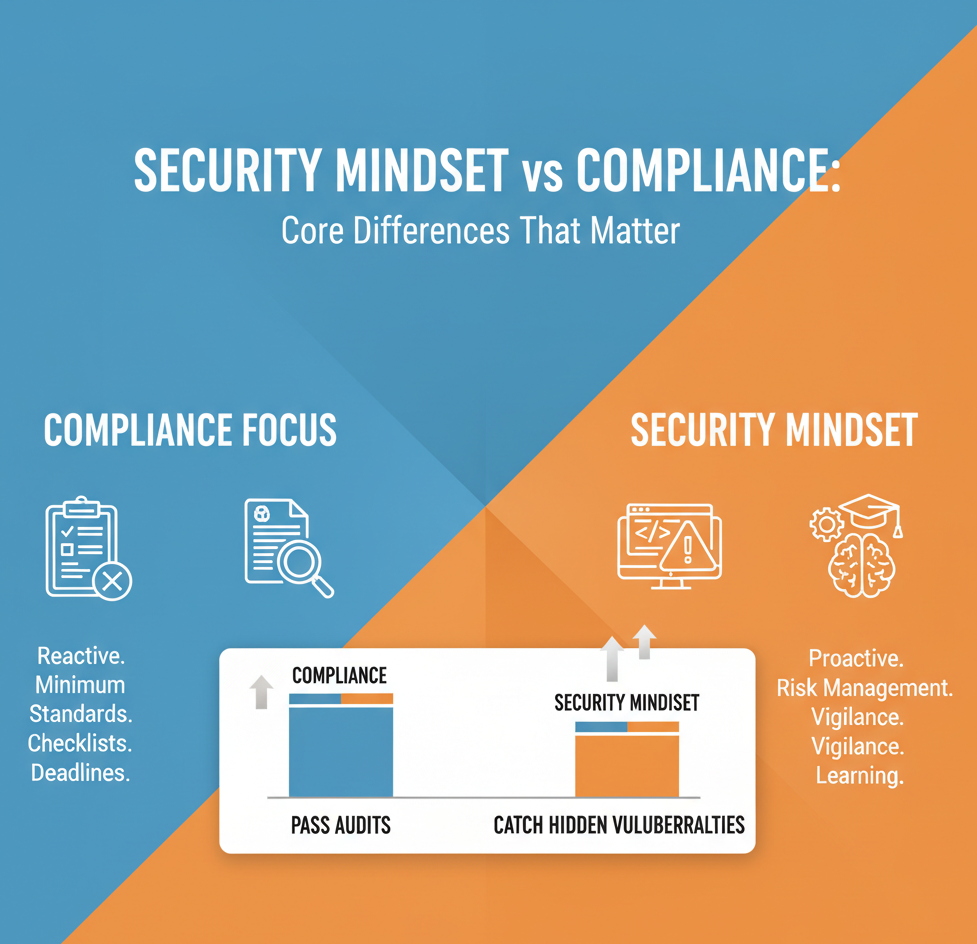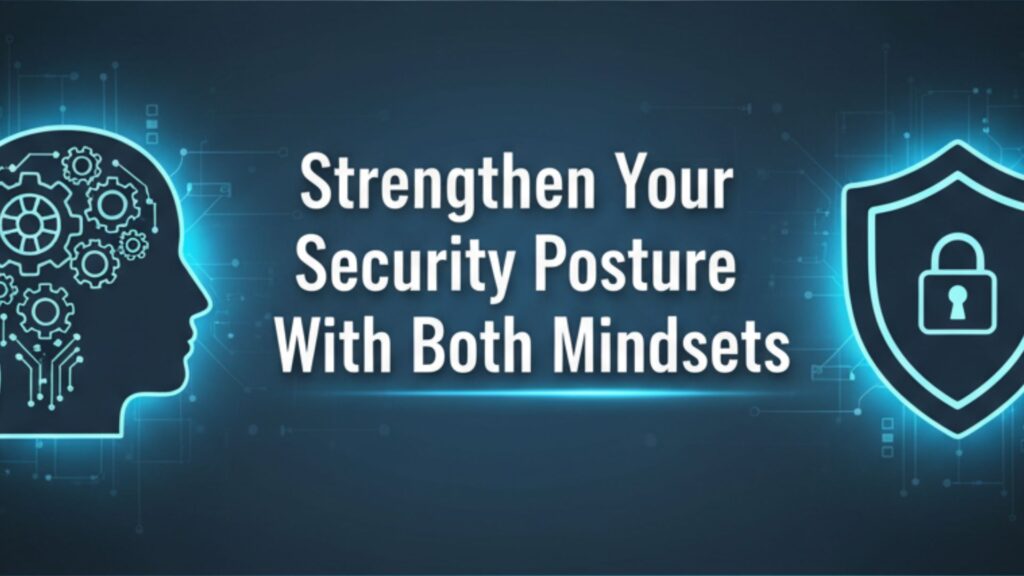
Security mindset and compliance aren’t two sides of the same coin – ask any developer who’s dealt with both. A security mindset means thinking like the bad guys, spotting weak spots before they become problems, and constantly tweaking our defenses. Compliance? That’s just ticking boxes to keep the regulators off your back (and yeah, sometimes paying hefty fines when you miss something).
We’ve seen plenty of companies nail their compliance audits while leaving their systems wide open to attack. It’s like locking your front door but leaving all the windows open. After training thousands of developers, one thing’s clear – you need both mindsets working together.
Want to know how these pieces fit together in the real world? Keep reading.
Key Takeaways
- You can’t just check boxes and call it security – real protection needs both mindset and rules
- Written policies keep everyone honest, but they won’t stop a determined hacker
- Smart defense layers security thinking on top of basic compliance rules
Understanding the Security Mindset: Proactivity Over Reactivity
Nobody likes surprises, especially when it comes to security breaches. Our bootcamp students often come in thinking security’s all about following rules, but that’s barely scratching the surface. The real importance of security mindset in coding shows when developers learn to think like attackers, spotting weaknesses before they’re exploited.
Back when we started training developers, most teams were stuck in reactive mode. They’d wait for some audit to flag problems or worse – for something to actually break. These days, we teach our students to ask the uncomfortable questions: “Sure, the firewall passed inspection, but what if someone’s already inside?” or “What happens when (not if) someone clicks that phishing link?”
Here’s what makes security thinking different:
- Looking for weak spots before they become problems
- Staying flexible as threats change (because they always do)
- Building systems that can take a punch and keep running
Sometimes this slows things down. People get annoyed when we make them think through every what-if scenario. But after seeing enough companies scramble after a breach, we know it’s worth the extra time. Much better than explaining to the boss why customer data’s showing up on the dark web.
Compliance: The Baseline Rulebook You Can’t Ignore

Nobody loves paperwork, but skipping compliance isn’t an option. Those HIPAA, PCI DSS, and GDPR rules? They’re there for a reason. Through years of teaching secure development, we’ve watched countless teams go through the motions – checking boxes, filing reports, doing whatever it takes to pass audits.
It’s tedious but necessary stuff, as healthcare breach reports often show (HIPAA Journal).[1] The thing is, compliance gives companies a way to prove they’re doing the bare minimum. It’s like having a driver’s license – shows you know the rules, but doesn’t mean you’re ready for the Indy 500.
Last quarter, our team worked with a healthcare startup that passed every HIPAA audit with flying colors. Still got hit with ransomware though, because they stopped at compliance and called it a day.
- Must-have frameworks: HIPAA, PCI DSS, GDPR, ISO 27001
- Key elements: Documentation, controls, regular audits
- Primary goal: Meet legal requirements, avoid fines
- Common trap: Thinking compliance equals security
Look, compliance sets the ground rules. But treating it like your whole security strategy? That’s like bringing a knife to a gunfight.
Security Mindset vs Compliance: Core Differences That Matter

The gap between compliance and real security hits you hard in the field. Working with dev teams across different industries, patterns start jumping out. Compliance folks love their checklists – security minds are always looking around corners, hunting for what might go wrong next.
Some companies do everything by the book, pass every audit, then get blindsided by attacks nobody saw coming. Others build security into their DNA, training developers to spot weird behavior patterns and lean on the characteristics of a security mindset to stay ahead. We’ve had bootcamp students catch major vulnerabilities that flew right past compliance reviews.
When deadlines loom and budgets get tight, that’s when you really see the difference. Compliance teams rush to file reports while security teams lose sleep over that one strange log entry that doesn’t look quite right.
Why Combining Security Mindset With Compliance Works Best
The smart play? Use both. Start with those compliance checklists – they’re actually pretty decent at covering the basics. But don’t stop there. Build a culture where everyone thinks like a defender (and sometimes like an attacker).
Our most successful students get this. They learn the rules cold, then figure out how to break them – ethically, of course. That’s how you spot the gaps between “compliant” and “secure.”
- Run those required scans, but also do your own deep dives
- Document everything (compliance loves that), but keep asking “what if?”
- Train your team beyond the annual security awareness checkbox
- Watch those audit scores, but pay more attention to actual incidents
- Mix policy requirements with street-smart security practices
When companies nail this combo, magical things happen. Security becomes everyone’s job, not just something the compliance team worries about quarterly.
Practical Steps to Build a Security-First Culture Within Compliance
Credit: Gust
To move beyond compliance and develop a security mindset, consider these approaches:
Embed continuous monitoring and threat detection. Don’t wait for the next compliance audit to find issues. Use security monitoring tools and vulnerability management to catch risks early.
Encourage employees to question and report. Train your teams to think like attackers and report suspicious activity. Security awareness programs should go beyond compliance mandates.
Develop flexible policies. Avoid rigid rules that hamper security agility. Policies should allow for rapid response to new threats and changing business needs.
- Invest in incident response and business continuity planning.
- Use risk assessment tools that focus on real threats, not just compliance gaps.
- Regularly update security controls based on evolving cyber risk intelligence.
Security mindset and compliance aren’t mutually exclusive. By embedding proactive thinking within your compliance framework and cultivating a security mindset, you create a multi-layered defense that’s both accountable and resilient.
Real Lessons From Our Experience
Three years back, we got a frantic call from a client. They’d just been hit with a nasty zero-day exploit, despite having perfect PCI DSS paperwork. Everything looked great on paper – their audits were spotless, documentation pristine. But that didn’t stop the attackers who found a hole nobody’d spotted yet.
The cleanup wasn’t pretty. Their team spent weeks rebuilding systems and explaining to customers what went wrong. That’s when they finally decided to take our advice about going beyond the basics. Together, we rebuilt their security from the ground up.
- Ran weekly phishing tests that felt real (not those obvious fake ones)
- Set up monitoring that actually watched for weird patterns
- Got their devs doing incident response drills (even at 3 AM)
- Built detection systems that caught stuff compliance never looked for
Now they’re different. Sure, they still do all the compliance stuff – but their team spots problems before they blow up. Last month, they caught an attack pattern nobody’d seen before. That’s what happens when you mix street smarts with checkbox security.
Strengthen Your Security Posture With Both Mindsets

Look, here’s the deal – you can’t just pick one or the other. Compliance keeps the auditors happy and gives you a decent starting point. But that security mindset? That’s what keeps you ahead of the bad guys who don’t care about your compliance certificates.
Every bootcamp class, we see the light bulb moment when developers get this. They realize those security checkboxes are just the beginning. Real security means thinking like both defender and attacker, staying paranoid (in a good way), and never assuming you’re safe just because some audit says so.[2]
The companies that get it right use both. They build solid compliance programs but keep pushing beyond them. They train their people to spot threats nobody’s written rules about yet. And when something goes wrong – because something always does – they’re ready for it.
Conclusion
Security’s real strength doesn’t come from just checking boxes. Sure, compliance sets up those basic rules everyone needs, but a security mindset pushes things further. You can’t pick one over the other, they work together. A good defense needs both. Think about it: your team might nail every compliance audit but still miss real threats. That’s why you’ve got to build a culture that cares about security, not just following rules.
Ready to turn compliance into confidence? Take your team’s mindset to the next level, Join the Secure Coding Practices Bootcamp and start building a security culture that lasts.
FAQ
What are the main security vs compliance differences, and how do they affect risk management and regulatory compliance?
A security mindset is about thinking ahead of threats, while a compliance framework follows set rules. Both help build a strong security posture. Risk management connects the two by looking at real-world risks and legal regulations. Understanding these security vs compliance differences makes it easier to balance cybersecurity goals with compliance requirements.
How does a compliance audit compare to a security risk assessment in finding security vulnerabilities and compliance challenges?
A compliance audit checks if you meet compliance standards like ISO 27001 or HIPAA compliance, while a security risk assessment looks deeper at security vulnerabilities and operational security gaps. Together, they help with audit readiness, strengthen security controls, and address compliance challenges before they become bigger problems.
Why does a security mindset need continuous monitoring, incident response, and defense in depth alongside compliance requirements?
Compliance requirements set baseline security, but continuous monitoring, incident response, and defense in depth prepare you for today’s threat landscape. A security mindset helps improve operational security and data protection by spotting security gaps early. This makes compliance verification stronger and keeps your security strategy realistic and adaptive.
How do compliance standards like PCI DSS, GDPR compliance, and cybersecurity regulations connect with security best practices and security culture?
Compliance standards such as PCI DSS, GDPR compliance, and cybersecurity regulations guide organizations on data protection and legal regulations. But security best practices, security awareness, and a strong security culture keep people engaged beyond the audit checklist. Mixing both builds cyber resilience and makes security improvement an ongoing effort, not just tied to compliance reporting.
What role do security frameworks, security controls testing, and governance risk compliance (GRC) play in a long-term compliance roadmap?
Security frameworks guide IT security strategies, while governance risk compliance (GRC) manages regulatory requirements and compliance documentation. Security controls testing checks for compliance enforcement and continuous compliance. Together, they shape a compliance roadmap that supports audit frameworks, business continuity planning, and security investment for long-term security improvement.
How can vulnerability management, phishing prevention, and password policies reduce security incidents and support compliance verification?
Vulnerability management finds weaknesses, phishing prevention reduces human error, and password policies limit risky access. Together, they cut down on security incidents and close security gaps. These steps also support compliance verification, compliance automation, and compliance management by showing proof of security risk mitigation in audit trails and compliance reporting.
References
- https://www.hipaajournal.com/healthcare-data-breach-statistics/
- https://en.wikipedia.org/wiki/2021_Microsoft_Exchange_Server_data_breach

